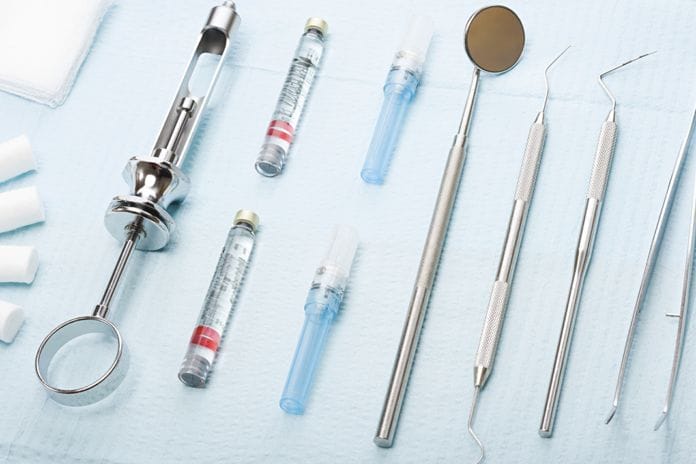It’s time to breakup with the Inferior Alveolar Nerve Block
As a seasoned educator and content expert in the delivery of dental local anesthesia, I find most of my esteemed colleagues, myself included, share a profound frustration over the seemingly inadequate anesthesia delivered to achieve mandibular numbness. In simplest terms, the provision of mandibular anesthesia has most commonly been the job of the Inferior Alveolar Nerve Block (IANB); a job, I must say, that has left much to be desired. Of note, the IANB has a published failure rate between 31-81%5.
To put it frankly, the IANB is the equivalent of that old ex-boyfriend who is always there to answer your phone calls but soon leaves you feeling alone, disappointed, and questioning your judgment. We have all experienced this destructive relationship in some way, so I’m here to tell you that you are not alone. I, too, dipped my toes in the hopeful waters as my eager “are you numb?” question was met with indifferent patient reactions. I, too, dropped my head in defeat as I felt the judging eyes of my patient question my clinical technique. I, too, did the walk of shame as I retrieved yet another cartridge from the drawer to try another substandard technique in a desperate attempt to achieve total numbness for my patient.
It was in those moments that I felt I wasn’t getting enough from my relationship with the IANB. As with any unsatisfying relationship, I sought the affections of other injections to compensate where the IANB was lacking. Sure, the Incisive Nerve Block was there for me in a pinch, it always did what it was supposed to do, and it never complained. But when I thought about the tremendous time and effort I spent walking on eggshells around my insecure relationship with the IANB; I soon realized I could do better.
About eight years ago, I finally broke up with the IANB for good, and I have never looked back. Let’s face it: there is a reason it’s called the IANB: because it is INFERIOR to other mandibular injection techniques. Its relatively high incidence of inadequate anesthesia meant it was not reliable enough for me, its requirement of additional needle penetrations in order to achieve buccal anesthesia meant it inflicted more pain to my patients and, to be honest, there are plenty of other attractive and far more successful injections in the sea. So here it is for the whole dental hygiene world to read, my breakup letter to the IANB:
Dear IANB,
I’m leaving you. I can’t do this anymore, and here’s why:
You were never reliable!
It has become abundantly clear to me that even though I have the talent and skills to deliver an appropriate IANB, you simply were not as reliable as I once thought you to be.
Between the coronoid notch, pterygomandibular raphe, and holding my breath while hoping to contact bone, it was clear that your technique was too sensitive. When we first met back in our college days, I learned that the greatest depression of the coronoid notch provides the perfect landmark for identifying precisely where the mandibular foramen is located. Placing my needle bevel 2-3 mm above the coronoid notch should have placed my anesthetic solution well above the mandibular foramen, thus anesthetizing the Inferior Alveolar nerve prior to its entrance into the mandibular canal.
However, in a study of skulls by Dr. Gow-Gates3, it was detected that in an estimated 14% of patients, the mandibular foramen was located well above the coronoid notch. It’s no wonder that my greatest efforts to deliver the most perfect injection, at the correct height, were met with unsuccessful anesthesia in a percentage of my patients whose inferior alveolar nerves were left untouched.
You’ve got some nerve!
I wish I could say that you got on my nerves, but quite frankly, that just wasn’t the case. In fact, there were many cases where your technique put me nowhere near the right nerves! Many patients present with a bifid inferior alveolar nerve or a bifid mandibular canal. In these cases, despite my best efforts to ensure I was placing my needle superior to the mandibular foramen, the accessory innervation from supplemental canals led to unsuccessful anesthesia for my patients and, yet again, another disappointing anesthesia experience for me.
Additionally, the controversy over the possible accessory innervation to mandibular teeth by cervical nerves, while unresolved, does prove that my valiant efforts to direct my anesthetic at the inferior alveolar nerve still left accessory innervations leading to unsuccessful anesthesia.
In the cases, where my patients reported a profound sense of anesthesia but still experienced accessory innervation in localized lingual sites, I knew you just weren’t there for me. Imagine my surprise when I learned that in approximately 60% of patients, there is accessory innervation from the mylohyoid nerve2; a nerve that is not routinely anesthetized by your technique.
You took it too far, and I didn’t feel safe!
I cannot tell you the number of books I read and courses I took to help me better prepare my approach with you only to find you would take things too far, especially when my needle experienced over insertion with no boney contact.
Moments of no boney contact meant I needed to perform corrections of repositioning. Every withdrawal and correction put my patient at increased risk for paresthesia and/or hematoma. Additionally, over insertion means that my needle tip could have been resting within the parotid gland. This could place my patient at risk for transient blockade or paralysis of the facial nerve if anesthetic was delivered within the gland. The fact that there were safety issues in our relationship should have been enough for me to walk away a while ago.
And don’t get me started on your little issue with premature boney contact
That’s right, the secret is out: I can’t tell you how many times we experienced premature boney contact together. The boney resistance met after penetration meant I was misinterpreting my patient’s notch or raphe anatomy; anatomy which is incredibly variable depending on anatomical variances of the ramus.
Many times, an aberrant lingula blocked my needle from contacting the medial body of the ramus. Other times, premature contact was related to boney prominences on the medial surface of the ramus at the internal oblique ridge. And yet other times, the flare of the ramus impacted the angulations required to reach an optimum deposition site.
After all of the back and forths, I’ve realized that every time I loaded my syringe, I was essentially guessing. Listen, IANB, I’m tired of the games.
I’m cheating on you
For a while now, I’ve needed to seek supplemental injections to help make up for your inadequacies such as the mylohyoid injection, the mental, the incisive and the mandibular infiltration with Articaine. What do they have that you don’t? For starters, the mandibular infiltration has an 88% success rate5, and the mental, incisive and mylohyoid injections boast a rare failure with ease of technique. When I think about the time I spent between tip-toeing around you, your lingual and long buccal technique, I find myself wondering why I stayed with you as long as I did.
I’ve moved on
Since breaking up with you, my clinical success with regional mandibular local anesthesia has been abundant. I’m seeing a few other injections currently: The Loma Linda IA4 requires less technique, the Gow Gates is considered a true mandibular nerve block, and the Vazirani-Akinosi boasts a 93% success rate5. To say I’ve been happier, more successful, and more fulfilled since leaving you, would be an understatement.
So thank you, IANB, for the years of reflecting on my anatomical knowledge, physiological studies, and constant efforts to be a better clinician. With this letter, I have packed up my loupes and am on to better things because, let’s face it: it’s not me, it’s YOU.
Love always,
Katrina RDH.
References
- Bassett, K., DiMarco, A. Naughton, D. (2015). Local Anesthesia for Dental Professionals 2nd ed. Pearson. Lakewood, Washington. ISBN: 978-0-13-307771-1
- Blanton, P.L., & Jeske, A.H. (2003). Avoiding complications in local anesthesia induction, anatomical considerations. Journal of the American Dental Association, 34(7), 888-893.
- Gow-Gates, G.A., & Watson, J.E. (1977). The Gow-Gates mandibular block: Further understanding. Journal of the American Dental Society of Anesthesia, 24, 183-189.
- Krall, B. (2008-2009). The Loma Linda Inferior Alveolar Nerve Block Technique, from Loma Linda University School of Dentistry, the Local Anesthesia Manual.
- Malamed, S.F. (2013) Handbook of Local Anesthesia 6th ed. Elsevier, Evolve. St. Louis, Missouri. ISBN: 978-0-323-07413-1.










